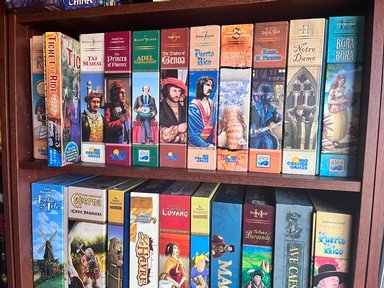Quiz Answer Key and Fun Facts
1. 1) I was first launched in the United States in the 1960s.
2) Players send opponents back to the start by landing on them.
3) Players never physically touch my die.
Which game am I?
2. 1) I was invented by sociologist James Cooke Brown.
2) The board is made up of an outer track and several minor loops.
3) A player wins if he's the first to complete his Success Formula.
Do you recognize me?
3. 1) I've been advertised as "The Game For Your Whole Brain".
2) I come with four different boxes of questions.
3) Two categories that a player may have to face are Factoid and Lexicon.
What intellectually challenging game am I?
4. 1) It is believed I'm descended from the Royal Game of Ur created around 3000 B.C.
2) My world championship in Monte Carlo each year draws thousands of players and spectators.
3) One of the most recent developments in my game is the doubling cube.
Which classical two player game am I?
5. 1) I was invented by Leslie Scott in 1974.
2) I come in varieties such as Throw 'n Go, Truth or Dare and Xtreme.
3) Rules state that only one hand at a time may be used to remove a piece.
Which of these hand-eye coordination games am I?
6. 1) There are no dice in my game.
2) My advertising slogan was "one minute to learn, a lifetime to master".
3) Effective strategies in my game involve gaining corners, edges and parity.
What traditional board game am I?
7. 1) I am one of the most well known games aimed at toddlers.
2) In 2005 Forbes magazine reported that I was the most popular toy from the 1940's.
3) Instead of rolling a die, players move by picking a card with a color on it.
Which children's game am I?
8. 1) In order to play I need two teams of at least two players.
2) A special viewer is used to read the card.
3) A team receives one point for coming up with each of ten items listed on the card.
Which popular party game am I?
9. 1) Designed by Klaus Teuber, I was first released in Germany in 1995.
2) Two of my cards are longest road and largest army.
3) To upgrade settlements to cities, it would be helpful to amass ore and grain.
Which civilization building game am I?
10. 1) I was created by Harvard graduate Allan Calhamer after his study of 19th century European history.
2) Unlike most games, all players' moves are put into effect simultaneously.
3) I'm particularly well suited for play by mail and even have my own fanzines.
Which of these strategy games sounds like me?
Source: Author
bottle_rocket
This quiz was reviewed by FunTrivia editor
gtho4 before going online.
Any errors found in FunTrivia content are routinely corrected through our feedback system.
